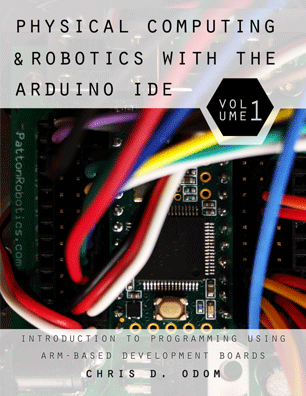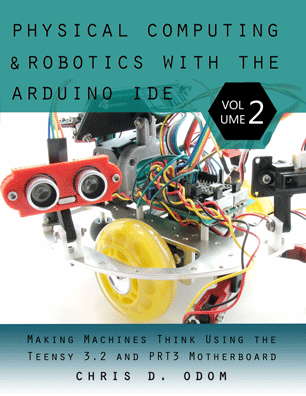 |
 |
The ultimate resource for students and educators interested in Physical Computing and Robotics
PCRDuino.com is the companion site for two of my textbooks, which cover a detailed and in-depth introduction to microcontroller programming, robotics, and electronics.
The Physical Computing & Robotics with the Arduino IDE textbooks are a compilation of three volumes. Here are the subtitles and descriptions of each volume:
- Volume One – Introduction to Programming using ARM-based Development Boards
This is in-depth volume teaches the complete novice how to program an ARM development board using the Arduino C programming language. The development boards specifically covered in this text are the Teensy 3.2 and Arduino Due.  BUY IT!
BUY IT! - Volume Two – The Art of Making Machines Think using the Teensy 3.2 and the PRT3 Motherboard
The second volume of the text continues with the Teensy 3.2 and makes extensive use of the PRT3 motherboard and OneBot mobile robotic platform from Patton Robotics. In Volume Two, the reader applies the lessons from Volume One to the exciting world of electronics, robotics, and physical computing.  BUY IT!
BUY IT! - Volume Three – Advanced Programming and Physical Computing Techniques with Guest Authors
- This book, which is still in draft form, is meant for readers who are already have microcontroller and robotic programming experience. Each chapter is composed by a guest author, usually one of my former students, and edited by me. Volume Three and covers advanced programming and physical computing techniques for a number of cool gadgets that were not covered in the first two volumes.
What are in these books?
Volume 1 of the textbook teaches the novice reader how to write code for any ARM-based microcontroller, specifically the Teensy 3.2 and Arduino Due development boards. Starting with Hello World, the reader moves through functions, data types, computer mathematics, serial keyboard input and output, logic statements, and loops. These are the foundations for all programmers whether they write code for desktop computers, smartphone apps, or robots. If you are new to programming, this is where you should start.
Volume 2 continues with the Teensy 3.2 and introduces the reader to the Patton Robotics PRT3.2 motherboard and OneBot mobile robotic platform. This second volume dives into the exciting world of electronics, robotics, and physical computing. Here, the reader learns how to program their own sensors and actuators, such as LEDs, buzzers, buttons, switches, servomotors, infrared (IR) and ultrasonic range sensors, and a wide array of environmental sensors that measure such things as light, temperature, force, flexion, pressure, soil moisture, etc.
Each volume contains:
- Hundreds of easy-to-follow code examples
- Dozens of self-test problems with detailed solutions
- Approximately 500 Challenge Problems
- Over 400 images and illustrations
Why Robotics?
Robots are the most exciting pedagogical tools to enter the classroom since the personal computer. Unfortunately, too many people believe that merely building a robot is the goal of robotics, or that simply playing around with one will propel today’s student into the academic stratosphere. “Place a few robots in a room full of students,” they say, “and watch the magic happen!” Well, it doesn’t happen by magic. It happens with superior products, hard work, and a thoughtful curriculum. Educational robotics is the means to an end, combining the best parts of science, math, and technology under one alluring concept. When properly taught, students are exposed to the exciting world of robotics while they cultivate a deep understanding of and love for math, science, and technology. That’s what it is all about. Education. Not robots.
About the Author:

A former atmospheric physicist and rocket scientist, Chris D. Odom started writing computer code as a seventh-grader in 1982. Since then, programming computers and embedded controllers has been an integral part of his academic and professional life. His computer applications were an essential part of his Bachelor’s, Master’s, and PhD work in experimental physics, and his early forays into physical computing included building homemade oscilloscopes and data acquisition systems for NASA sounding rocket payloads. Even though he is excited about science and technology, Chris’ passion lies in education, and he has taught at nearly every level, including middle school, high school, technical college, and research university. He is the author of multiple textbooks in the fields of physical computing, robotics, and physics, and he has developed numerous online tutorials in programming, robotics, and CAD design. He and his wife, Kathleen, live and work at George School in Newtown, PA. They have two daughters, Ivy and Josie.
Everything you need to get started programming your own Teensy or Arduino-based robot or embedded controller
You can purchase both volumes of the Physical Computing & Robotics textbook directly from the publisher (Lulu) or you can purchase them from Patton Robotics, LLC, which also sells the microcontrollers, electronics, robots, and components referenced in these books. The books are the same price at both vendors. If you need the books in a hurry, Patton Robotics keeps an inventory on hand, ready for immediate shipment. Lulu is a print-on-demand publisher, so it takes 2-3 days to print the books before they are shipped out.
Volume One$29.48 / B & W / Spiral$42.77 / Color / Paperback
|
Volume Two$33.33 / B & W / Spiral$49.82 / Color / Paperback
|
 |
 |
BUY THEM QUICKLY from Patton Robotics!BUY THEM DIRCTLY from LULU!
|
|